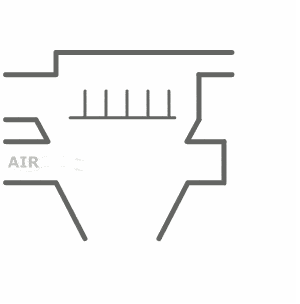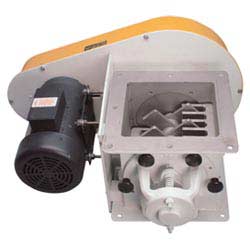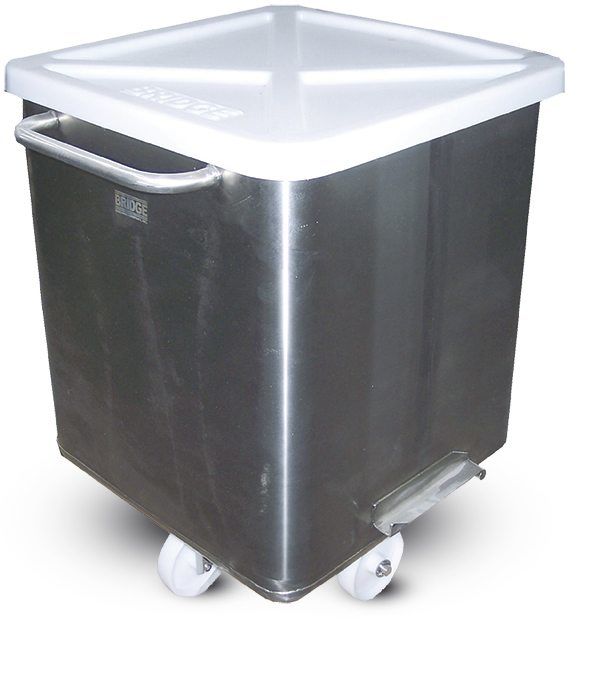
The terminology used in industries relating to weighing, batching, mixing, and automation can often be confusing and vary from company to company or industry to industry. This section of Sterling Systems & Controls website is designed to provide clear and understandable definitions of various terminology used both in industry and on our website.
The terminology will be arranged alphabetically but may be out of order for a time while it is being developed. We thank you in advance for your patience and hope this Terminology section is beneficial to all visitors.
A

Airlock: (a.k.a Rotary Airlock) In bulk material solids handling and processing an airlock or rotary airlock is a device that not only controls the feed rate of the bulk material but also minimizes air leakage (pressure loss) between equipment above and below the airlock valve that have differing levels of pressure. It is a type of valve used specifically to minimize or eliminate air or pressure loss between above and below the airlock valve.
Auger Feeder: An Auger Feeder, a.k.a. Screw Feeder, is a type of dry material feeder commonly used in minor and micro ingredient batching systems to feed material from each ingredient supply bin to a weigh scale or scale hopper. The screw feeder could adjust its feed rate based on the screw or auger size, the number and shape of individual flights on the screw or auger, and the speed of the drive for the feeder.
Automation: Automation can be defined in a few different ways. But for our purposes here Automation is the application of technology in a custom-engineered manner to monitor and control a process of production, such as the production and delivery of various goods and services in a wide range of industries. Automation will perform tasks or processes that were previously performed manually by operators (human beings). Sometimes Automation is referred to as Process Control, which it is, but Automation can be the application of technology to automate things other than processes. Industries where automation is routinely employed include agriculture, food manufacturing, chemical production, refining, and many other industries.
Automatic: This terminology section will define the term Automatic in regard to a Batching System. A batching system has two functions which can be done either manually or automatically. In a Manual manner, an operator performs the function. In Automatic the system automation performs the task in some manner. In batching systems the function of feeding each ingredient into the batch container/transport and then delivering each completed batch to the next step in the process.
B

Bakery Stack-up: A term used in the baking industry batching system arena. Multiple components are stacked one on top of another to create the material batching and weighing system. Refer to the picture here.
Banbury: A mixer type. Banbury is a registered trademark owned by the Farrel Corporation. Banbury is a type of mechanical mixer primarily used in rubber and plastic compounding, known for its ability to force the cohesion of these materials. Process control of a Banbury mixer is and expertise that few have, including Sterling Systems & Controls.


Batching System: In the process manufacturing industries such as feed, food and many others, a “batching system” is one in which the semi-automatic or automatic collection of multiple ingredient dry solids and/or liquids. The dry and liquid ingredient materials are either automatically or manually fed into a collection container or automatically transferred to the next process step, such as a mixer, via mechanical or pneumatic conveyance. Batching systems may also be referred to as Micro Ingredient Batching Systems, Minor Ingredient Batching Systems, Bulk Batching Systems, Automatic or Semi-Automatic Batching Systems (automatic and semi-automatic refers to the feeding of ingredient materials), Material Weighing Systems, Material Batching Systems, Hand Prompt Batching Stations (referring to the system which prompts an operator to manually feed material ingredients into a batching container), and Kitchen Systems.

Batching Stations: What is a batching station? The term “batching station” can be defined as the location for the operator interface to the batching control system. Usually, there is a single batching station (control panel) in a batching system, but sometimes there can be multiple batching stations. A blog post on multiple batching stations can be found here.
Bearing Condition Monitor for Classifiers: Classifiers and Grinders are particle size reduction machinery. Classifiers and Grinders are rotating process equipment. As such they have bearings. These bearings are critical to the safe operation of the equipment. Bearing failure can result in equipment downtime and safety problems. Monitoring the status of the bearings and overall equipment function is what Bearing Condition Monitors do. Specific Bearing Monitors are available for the Prater Industries brand of particle size-reducing classifiers and grinders. The data sheet for BEARING CONDITION MONITOR FOR PRATER MILLS AND CLASSIFIERS is available at this link. These Condition Monitoring panels monitor vibration, acceleration and temperature and are invaluable for critical processes.
Bin: A “bin” is a container for material, typically for bulk solid materials rather than liquids (see “tank”). A bin typically has one or more outlets for removal of the material and usually a single inlet, though there could be more. Discharge of the material through the bin outlets is either by gravity or by some devices that promote flow or devices that assist gravity.
Bulk Bag: A bulk bag is also referred to technically as an FIBC, or Flexible Intermediate Bulk Container. These bags are containers to hold dry materials, powders and granular materials. They are made of flexible fabric, such as polyethylene or polypropylene. They expand to fit the dry material. They have an opening in the top and a discharge or outlet in the bottom of the bag. A wide variety of flexible bulk bag containers exist with differences in shape, inlet, discharge, etc. Filling and Emptying FIBC’s are accomplished with specialized process equipment custom-engineered and manufactured to fit the specific application requirement. These machines are often equipped with scales and weighing systems. Bulk Bag Filling/Packaging Systems and Bulk Bag Discharge/Unloading Systems.
Bulk Material Handling: This is an engineering field involved with the design of equipment used for the handling of bulk dry materials such as those which are powdery, granular or lumpy in nature, and are stored in “heaps” in bins, silos, open piles, etc. Often bulk material handling systems are engineered for moving dry materials from one point to another. The ability of a dry bulk solid material to flow is a function of the material and the equipment handling it. An easy-flowing bulk solid material placed in the wrong piece of equipment can become difficult to handle. If it is placed in the correct equipment, it can flow reliably. There are methods that can be employed to promote the flow or movement of bulk solid materials. Mixing and blending of bulk solids is an important processing step in many industries. Batching incorporates the feeding of dry bulk solid materials into a “batch” for mixing or other downstream processing.
C
Controls: a.k.a. Process Controls, related to Automation.
Conveyor: A conveyor is a mechanical apparatus that transports material. Many different kinds of conveyors exist. For our context here we are talking about and defining conveyors that are used to transport bulk dry materials, powders, granular materials, etc. In bulk material conveyors there are generally two types, pneumatic and mechanical drag. Both pneumatic conveyors and drag conveyors are defined within this Terminology section.
Classifier: A classifier is a piece of process equipment that separates material based on a set of characteristics, such as particle size, density, etc. “Air Classifiers” provide a highly precise method for separating and classifying particles to the desired size and density. Classifiers are typically designed to provide ultra-fine separation and narrow particle distributions for dry bulk materials. Often air classifiers offer size separations in the range of 3 to 150 microns. They are ideal as a stand-alone process that includes a feeder and dedicated dust collection system. They are equally suited to “closed-circuit” grinding when coupled to a conventional milling system.
based on a set of characteristics, such as particle size, density, etc. “Air Classifiers” provide a highly precise method for separating and classifying particles to the desired size and density. Classifiers are typically designed to provide ultra-fine separation and narrow particle distributions for dry bulk materials. Often air classifiers offer size separations in the range of 3 to 150 microns. They are ideal as a stand-alone process that includes a feeder and dedicated dust collection system. They are equally suited to “closed-circuit” grinding when coupled to a conventional milling system.
D
Decision Table: Refer to Rules Table.
Drag Conveyor: No, this is NOT a conveyor dressed in drag. It is a conveyor named for its method of moving granular and powder material by dragging it from point A to point B. They can be used to move material in elevation as well as in linear motion. Typically consisting of a drive chain and paddles or blades that capture and “drag” material along. One reason for using drag conveyors is they are more flexible in terms of the type of material they can move, wider range of bulk densities, particle size, etc.
Typically the sizing of a drag conveyor depends upon:

- What the conveyor is to handle
- What the average particle size will be
- What the expected amount of material is that needs to be moved, such as described in Tons Per Hour
- How the drag conveyor will be loaded
- At what elevation the drag conveyor will discharge
- What is the horizontal distance from the center of the inlet to the center
of discharge, etc.
 Drawer-In-Housing Magnetic Separator: Also known as “drawer magnets” consist of rows of round magnetic tubes that are assembled into drawers contained inside a housing. The magnetic tubes of each row are aligned on alternating centers from the row directly above or below it. As the product flows into the top of the housing, it is forced to cascade in a Zig-Zag pattern from row to row over the magnetic tubes. This ensures maximum tramp metal capture since the product comes in direct and repeated contact with a magnet as it travels through the housing.
Drawer-In-Housing Magnetic Separator: Also known as “drawer magnets” consist of rows of round magnetic tubes that are assembled into drawers contained inside a housing. The magnetic tubes of each row are aligned on alternating centers from the row directly above or below it. As the product flows into the top of the housing, it is forced to cascade in a Zig-Zag pattern from row to row over the magnetic tubes. This ensures maximum tramp metal capture since the product comes in direct and repeated contact with a magnet as it travels through the housing.
Dryer: A Dryer removes moisture to reduce or eliminate said moisture from a powder or other bulk solid. Industrial Dryers come in many forms or types including Fluid Bed Dryers, Rotary Dryers and Rolling Bed Dryers. A good source of additional information regarding the types of industrial dryers available is the “Industry Master”
Dust Collector: Processing of powder materials can create airborne dust. This can be problematic in many situations and hazardous. From toxic to explosive dust, this problem can cause property damage, injury and loss of life. Therefore, when airborne dust can be created in a process it usually requires being contained and collected. This is common in material weighing and batching applications. A dust collector is used to collect and provide temporary storage of dust from a process point.
E
F

Feeder: The terminology word “feeder” is used as a noun within the context of batching systems. A Feeder is a device or person that moves ingredients in a batching system from the ingredient container to the weighing scale. Automatic batching systems use automated feeders such as screw (auger) type or vibratory type feeders. In semi-automatic batching systems or manual batching, a person or operator is used as the “feeder”. Usually, the operator uses a scoop to move an ingredient from its container to a weighing container on a scale. The advantages of Sterling Systems screw or auger-type feeders are numerous.
G
Grinder: The term Grinder in this industrial perspective is a generic reference to a piece of process equipment that reduces the particle size of a bulk solid material. There are several different types of “Grinders”, each defined by some aspect of its method of operation, such as a Hammermill, an Air Classifier, a Ball Mill, Roller Mill, Pin Mill, Jet Mill and Colloid Mill. Some go beyond just particle size reduction, such as a classifier.
H

Hammer Mill: A Hammer Mill is one of the oldest particle reduction machines available today. A Hammer Mill consists of a series of hammers (usually four or more) hinged on a central shaft and enclosed within a rigid metal case. The bulk solid materials to be milled or reduced in particle size are struck by these “hammers” (rectangular pieces of hardened steel) which rotate at high speed inside the chamber. These radically swinging hammers (from the rotating central shaft) move at a high angular velocity causing brittle fracture of the bulk solid material.
Hand Prompt Batching System: Also known as “Hand Adds”, a Hand Prompt Batching System (or batching station) is a semi-automatic batching system. Refer to the “semi-automatic”  definition further below. Offering the many benefits of ingredient batching systems, the hand prompt system includes ingredient lot tracking, automatic weighing of operator-added ingredients within a user-programmable tolerance, formula creation and storage, and inventory tracking. The hand prompt batching system is entry-level or least expensive of automated ingredient batching systems but offers many important features and several high-end options. More information.
definition further below. Offering the many benefits of ingredient batching systems, the hand prompt system includes ingredient lot tracking, automatic weighing of operator-added ingredients within a user-programmable tolerance, formula creation and storage, and inventory tracking. The hand prompt batching system is entry-level or least expensive of automated ingredient batching systems but offers many important features and several high-end options. More information.
I
Industrial Magnetics: Industrial Magnetics, Inc. is a manufacturer of magnet solutions, specifically for tramp metal removal from bulk solids. Industrial Magnetics provides many off-the-shelf industrial magnet products but it is their ability to provide customer-specific solutions to unique problems that sets them apart from others in the industry.
J
K
L
Level Sensor: a.k.a. Level Control, Bin Level Indicator. A level sensor can be either a point or continuous level device. Point-level sensors monitor for the presence or absence of material in a bin at a predetermined point, such as a high level or low level. Usually in batching systems level sensors are of the point type and are used for monitoring low-level conditions in ingredient bins. Continuous level sensors measure the continuously changing level of material, up and down, as the material in a bin, tank or silo vessel goes up and down with material usage and resupply.

Lump Breaker: Sounds ominous. What is a lump breaker? It’s just what it sounds like, a piece of process equipment used to break “lumps” in the flow of dry solid materials. They are used to break up materials that tend to clump because they are hygroscopic, meaning the particles tend to absorb moisture and then bind together and create larger particles too big to flow easily. These lumps or clumps can block flow streams and must be broken up. A lump breaker is usually a form of rotary airlock and a.k.a. lump crushers. They are a form of particle size reduction equipment. For more information see the Lump Breaker web page.
M
Manual: In the batching function a “manual batching” system is one that uses an operator to feed ingredients into a batch container on a scale for weighing, and also the operator manually moves the completed batch in the batching container to the next step in the process which is typically a mixer and dumps the batched ingredients into the mixer. Both the feeding of ingredients and the movement of completed batches are done manually, by an operator.
Metal Finish: Refer to “Surface Finish Grades”.
Micro: This term is generally used in describing the general weighment size for an automatic batching system. In an automatic batching system the ingredients, based on the chosen formula to be made, are fed from the ingredient supply bin the the appropriate scale hopper for weighing an accurate amount according to the formula being run. A “Micro” weighment (refer to definition of “Weighment” within this Terminology page) is generally anything less than 50lbs (22.7Kg). Often weighments are as low as several grams and the scale hoppers can be relatively small. The term “micro” in regard to ingredient batching systems is often generically used in the Feed industry regardless of weighment size.
Minor: This term is generally used in describing the general weighment size for an automatic batching system. In an automatic batching system the ingredients, based on the chosen formula to be made, are fed from the ingredient supply bin the the appropriate scale hopper for weighing an accurate amount according to the formula being run. A “Minor” weighment (refer to the definition of “Weighment” within this Terminology page) generally runs from 50lbs (22.7Kg) up to around 150lbs (68.2Kg). Often micro weighments are as low as several grams and the scale hoppers can be relatively small. The term “minor” in regard to ingredient batching systems is often generically used in the Food and Baking industry regardless of weighment size.
N
O
P
Particle Engineering: This is best understood by review of a blog post from a company that is a leader in particle engineering and size reduction, Prater Industries.
Pipe Magnets: Pipe magnets provide product protection for many industries including flour, feed and grain, food processing, powder and bulk, chemical resin, plastic processing and more.
 Pneumatic Conveying: Simply put, pneumatic conveying is the conveyance of dry
Pneumatic Conveying: Simply put, pneumatic conveying is the conveyance of dry
material powder or small granular materials using air as the motive of transport. A wide variety of powder materials such as flour, cement powder and granular materials such as plastic pellets, can be conveyed using pneumatic transport. There are two forms of pneumatic conveying, i.e. Dilute and Dense phase. As stated, Dilute and Dense refer to the phase or state of the dry material within the pneumatic conveying lines. Dense phase pneumatic conveying will move the material in densely packed slugs of material. The dilute phase moves the material entrained within the air stream in a relatively uniform stream from the source of the material supply. More details can be found at this industry website. This is an international site and terms may vary depending upon the country you are in.
Pneumatic conveying can use positive or negative pressure. Negative pressure systems are vacuum systems, and positive pressure pneumatic conveying systems use a positive pressure blower. Pneumatic conveying within a batching system is used to move completed batches to the next process step, typically to a mixer. Most often negative pressure vacuum systems are used in batching systems.
Prater Industries: This is a company, related to Sterling Systems & Controls, that has decades of expertise in particle reduction and sizing for bulk solids in a wide range of industries. Their offering includes a range of equipment such as lump breakers, hammer mills, fine grinders, air classifying mills, rotary sifters, air classifiers, rotary airlock valve feeders, and more. All Prater Industries equipment, parts and systems are designed and built to provide years of low-maintenance, reliable service. Prater also offers highly skilled and experienced technical services on-site for start-up, troubleshooting, and preventative maintenance.
 Pulses: Pulses are the edible seeds of plants in the legume family. Pulses grow in pods and come in a variety of shapes, sizes and colors. The United Nations Food and Agriculture Organization (FAO) recognizes 11 types of pulses: dry beans, dry broad beans, dry peas, chickpeas, cow peas, pigeon peas, lentils, Bambara beans, vetches, lupins and pulses nes (not elsewhere specified – pulses that don’t fall into one of the other categories).
Pulses: Pulses are the edible seeds of plants in the legume family. Pulses grow in pods and come in a variety of shapes, sizes and colors. The United Nations Food and Agriculture Organization (FAO) recognizes 11 types of pulses: dry beans, dry broad beans, dry peas, chickpeas, cow peas, pigeon peas, lentils, Bambara beans, vetches, lupins and pulses nes (not elsewhere specified – pulses that don’t fall into one of the other categories).
Q
R
Rotary Airlock Valve: Refer to “Airlock”.
Rubber Compounding: Rubber is typically made as a compounding that blends together a variety of ingredient components designed to create a specific compound. The formula of ingredients consists of various chemicals including cross-linking agents, reinforcements, antidegradants and colorants. Important in rubber compounding is the batching of the various chemical ingredients together. More information on rubber batching can be found on this site.
Rules Table: A Rules Table, a.k.a. a Decision Table, in process control software applications, such as Batching, is a set of rules that have qualifications identified. In a Batching control system, the Rules Table feature will check Formulas to run against a set of Rules and verify if any are violated before the formula can be run. If any of the Rules in the Rules Table are being violated, the formula cannot run.
S
Semi-Automatic: A semi-automatic batching system differs from both the automatic and manual systems. It is a combination of the two. The semi-automatic batching system will automatically provide step-by-step instructions to an operator for creating a batch. The system automatically controls the process of proceeding from one step to the next by weighing and comparing the required amount and ensuring that the correct material has been used/added. The operator will feed each ingredient from its respective bin/box/container to the batch container for weighing on a scale controlled by the system. Once a batch is completed and verified by the system an operator manually moves or transports the batch container to the next step, typically to the mixer.
Surface Finish Grades: The roughness and quality of the surface finish of metal that is in contact with the customer material is of critical importance in many industries; be it an ingredient, final product, liquid or dry material. Industries such as food and pharmaceuticals require specialized finishes. Sterling Systems “PRODUCT FINISHING GRADES SURFACE FINISH” documents explain the finish of various grades of material and welds.
T
Tank: A “tank” is a container for material, typically for liquid materials rather than solids (see “bin”). A tank typically has one outlet for the removal of the liquid and usually one or more inlets. Discharge of the material through the tank outlet is either by gravity or pressure/pumping.
Tank Calculator: Specifically a tank calculator is something that aids in your calculating the capacity of a tank. This could be a bulk tank or a liquid tank. In liquid tanks, there are several types, e.g. liquid flat bottom, liquid slope bottom, liquid hopper bottom, horizontal and liquid dish bottom designs.
Terminology: Terminology is the technical or special terms used in a business, art, science, or special subject, the nomenclature as a field of study.
Toll Processing: This is the process by which various processing functions can be performed by a third party for a charge. These processing functions could be Sifting, Milling, Grinding, Lump Breaking, Classifying and even Compacting. See the video here on Toll Processing.
Tramp Metal Separation: This equipment, magnetic separation equipment, is for the removal of ferrous and non-ferrous metal contaminants from dry or liquid product flows. This includes the use of magnets for gravity-fed flow (inside and outside the flow stream), conveyor-fed flow, pneumatic line flow, liquid line flow and specialty application flow metal separation.
U
V

V-Mag: The V-Mag is a container on wheels used typically in the meat processing industry but also in many other segments of the food and pet food industry carrying primarily dry materials for mobility. Ingredients can be “batched” into V-Mag containers or ingredients can be dumped from large bulk containers, like FIBC bulk bags, into the V-Mag container for movement throughout the processing plant.
Valve: A Valve is a mechanical device that regulates the flow of a dry or liquid material. The flow can typically be ranged from 0-100% by a valve. There are several different types of valves, depending on the application. Some are used exclusively for dry materials like powder or granular solids. Others are specifically designed for use with liquids. Common valves used for regulating the flow of dry materials like powders are the Rotary Airlock Valve and the Slide Gate, the Iris Valve and the Butterfly Valve (designs available for liquids as well).
W
Weighing System: A weighing system combines various components and automation to provide a self-contained system that allows operators to weigh and batch various materials or ingredients according to a recipe or formula. A weighing system can be semi-automatic or automatic. A.K.A. Batching System.
Weighment: No Terminology section would be complete without this specialized term, Weighment. A weighment is the weight measurement of a given item, ingredient, batch, etc. To determine the scale requirements for ingredients it is often necessary to know what the minimum and maximum weighment is for each ingredient. This means identifying the minimum and maximum weight value is of a specific ingredient. A weighment can be thought of as a single weight measurement value.
X
Y
Z
Working With Us
Give us a call today to talk about your business and process objectives and see how Sterling Systems & Controls can provide a custom engineered solution. You can reach us by phone at 1-815-625-0852, toll-free in the USA 1-800-257-7214, or by email at sci@sterlingcontrols.com.
